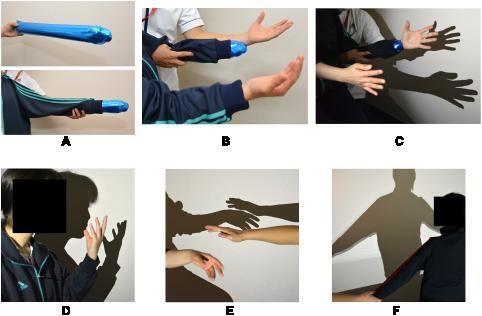Figures & data
Table 1 Changes in Evaluation Items
Figure 1 Body shadow methods. (A–C): 1st step, (D): 2nd step, (E): 3rd step, (F): shoulder adduction and abduction while looking at the body shadow. A cylindrical balloon was passed through the left sleeve of a long-sleeve shirt to imitate the patient’s left arm (A). The patient wore the shirt but did not pass her left arm through the sleeve; her left hand was projected as a shadow using the therapist’s left hand (B). When the body was projected, the patient repeatedly flexed and extended her right-hand fingers; the therapist also flexed and extended the fingers on his left hand in synchronization with the patient’s hand (C). Consequently, the patient’s motor intention and the visual feedback of the shadow formed an SoO and SoO over the body shadow of the left hand. Next, the imitated left arm was replaced with the patient’s own left arm. Consequently, using her body shadow, the patient was able to “touch” her face (D) and another person’s projected hand (E). Later, a body shadow of the patient’s whole body was projected, and she performed adduction and abduction of both shoulders while looking at the body shadow (F).

